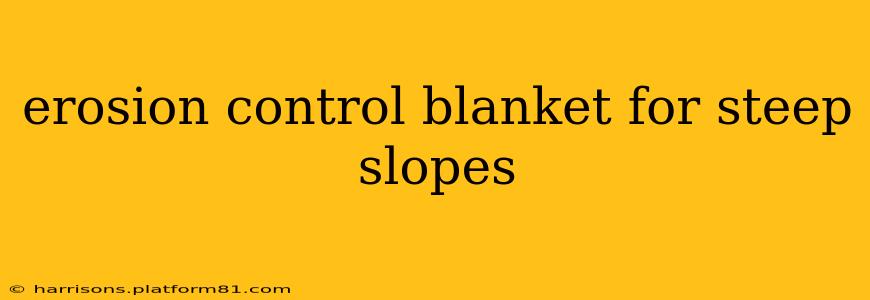Steep slopes present unique challenges when it comes to erosion control. The combination of gravity and often-sparse vegetation makes these areas highly susceptible to soil loss, landslides, and water damage. Erosion control blankets offer a robust solution, providing a protective layer that stabilizes the soil and promotes vegetation growth. This guide explores the various aspects of using erosion control blankets on steep slopes, answering key questions and offering expert insights.
What are Erosion Control Blankets?
Erosion control blankets are engineered fabrics designed to protect soil from the erosive forces of wind and water. They come in a variety of materials, including biodegradable and non-biodegradable options, each suited for different applications and slope conditions. These blankets typically consist of a matrix of fibers, often interwoven with netting or other reinforcing materials, sometimes including a layer of mulch or other organic matter. They're installed on the soil surface to prevent runoff, retain moisture, and promote seed germination.
How Effective are Erosion Control Blankets on Steep Slopes?
The effectiveness of erosion control blankets on steep slopes depends on several factors including the blanket type, the slope's angle, soil conditions, and the overall environmental conditions. However, when properly installed and selected for the specific site conditions, they are highly effective at minimizing soil erosion. They create a stable surface that resists the forces of gravity and water runoff, preventing the topsoil from being washed away. The added organic matter in some blankets also helps improve soil structure and fertility.
What Types of Erosion Control Blankets are Best for Steep Slopes?
Choosing the right erosion control blanket is crucial for success. For steep slopes, you'll generally want a blanket that offers superior strength and stability. Consider these factors:
- Fiber Type: Blankets made from coconut coir, jute, or a blend of natural and synthetic fibers often provide excellent strength and biodegradability, which is beneficial for long-term environmental integration. Synthetic blankets might be more durable in extreme conditions.
- Weight: Heavier blankets offer better stability on steep slopes, resisting the pull of gravity and offering greater protection against high-velocity water flow.
- Permeability: The blanket should allow for adequate water infiltration to support plant growth while still preventing surface runoff.
Often, a combination of techniques including hydroseeding or other vegetation establishment methods is used in conjunction with the blankets for optimal results.
How are Erosion Control Blankets Installed on Steep Slopes?
Installing erosion control blankets on steep slopes requires careful planning and execution. The process generally involves:
- Site Preparation: Clearing debris, leveling the surface, and preparing the soil for optimal seed germination is critical.
- Blanket Placement: This can be challenging on steep slopes and may require specialized equipment or techniques to ensure proper coverage and prevent slippage. Stapling or pinning the blanket securely to the soil is essential.
- Securing the Blanket: Methods such as anchoring with erosion control staples, netting, or other fasteners help secure the blanket, especially on steeper slopes, preventing it from shifting or being washed away.
Specialized contractors experienced in working on steep slopes are often needed for proper installation.
What are the Alternatives to Erosion Control Blankets for Steep Slopes?
While erosion control blankets are highly effective, several alternative methods can be employed for steep slope stabilization:
- Terracing: Creating level platforms on the slope to reduce the gradient and slow down water flow.
- Revetments: Using materials like rock, concrete, or gabions to create a protective barrier against erosion.
- Vegetation: Establishing native vegetation that can stabilize the soil and resist erosion. Hydro-seeding is often utilized on steeper slopes.
These methods can be used alone or in combination with erosion control blankets to maximize effectiveness.
How Much Do Erosion Control Blankets Cost for Steep Slopes?
The cost of erosion control blankets varies significantly depending on the type of blanket, its size, and the amount needed for the project. The cost of installation is also a significant factor, particularly on steep slopes where specialized equipment or techniques may be necessary. Obtaining quotes from several contractors is recommended to compare pricing and ensure a good fit for your specific project.
How Long Do Erosion Control Blankets Last on Steep Slopes?
The lifespan of an erosion control blanket varies greatly depending on the material used, environmental conditions, and the overall effectiveness of the vegetation establishment. Biodegradable blankets will naturally break down over time, typically within 1-2 years. Non-biodegradable blankets can last significantly longer, but eventually, they will need replacement. The success of vegetation establishment greatly influences the long-term success and the need for further intervention.
By carefully considering these factors and employing appropriate techniques, erosion control blankets can provide a highly effective and sustainable solution for protecting steep slopes from erosion. Remember to consult with experienced professionals for guidance tailored to your specific site conditions.
